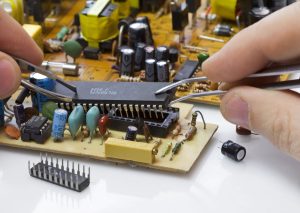 Preamble: We live in a scientific and technological world that is so different from the world of a hundred years ago that if someone from that time were to land in our midst today, they are sure to find most things around them magical. Each of the technologies surrounding us today had one or a few seminal patents, the potential of which was perhaps seen by few other than the inventors themselves. However, those patents have had an inordinate impact on several technologies that followed. Let us explore each month for the next few months, one or more such patents that changed the world.
Preamble: We live in a scientific and technological world that is so different from the world of a hundred years ago that if someone from that time were to land in our midst today, they are sure to find most things around them magical. Each of the technologies surrounding us today had one or a few seminal patents, the potential of which was perhaps seen by few other than the inventors themselves. However, those patents have had an inordinate impact on several technologies that followed. Let us explore each month for the next few months, one or more such patents that changed the world.
In my previous article on seminal patents, we explored the invention of the solid state device – transistors – which kickstarted the explosive growth of electronics. The next big thing in the field, or should we say the next small thing, was the integrated circuit. Let us see what the impetus for creating integrated circuits was.
Vacuum tubes were large, energy-gobbling, heat-generating devices that had to be assembled on large holders, not unlike bulb holders but with more terminals, fitted onto a metallic base. Transistors and associated passive components, on the other hand, could be assembled on printed circuit boards and hence were much more compact. In such circuits, often, two or more transistors are interconnected and are, in turn, connected to the other components. So, it was probably a logical step to wonder if the two interconnected transistors could be formed on a single piece of semiconductor material, say silicon.
Interestingly, the first integrated circuits came in the vacuum technology! A radio receiver was taxed based on the number of vacuum tube holders it had. So, to reduce the number of holders, a single tube with six pins was created, and it had three triodes, two capacitors, and four resistors.
Coming back to the subject of modern semiconductor integrated circuits (ICs), as can be expected, something as pathbreaking and complex ICs, even in their simplest form, needed many technologies. Further, there were also other more basic forms of integrated circuits before a practical, fully monolithic integrated circuit could be invented. However, Robert Noyce, working for Fairchild Semiconductors®, invented the first monolithic integrated circuit. But to be able to do this, he invented a way to connect the components forming the IC. This process was aluminium metallisation. He also invented an improved version of insulation based on the planar process technology developed by Jean Hoerni. Using these techniques, a group in Fairchild, led by Jay Last, created the first operational IC. However, Texas Instruments® (TI), which had patented Jack S. Kilby’s invention and created a prototype hybrid integrated circuit, sued Fairchild, and a patent war ensued. Eventually, an out-of-court settlement was reached.
The Nobel Prize in Physics in 2000 was awarded to Kilby and the announcement read, “for basic work on information and communication technology” with one half jointly to Zhores I. Alferov and Herbert Kroemer “for developing semiconductor heterostructures used in high-speed- and opto-electronics” and the other half to Jack S. Kilby “for his part in the invention of the integrated circuit”.
As mentioned earlier, so fundamental and complex an innovation is unlikely to have come from one inventor. Thus, there is no consensus on who invented the IC. In the beginning, four people were named Kilby, Lehovec, Noyce, and Hoerni. Later, it was attributed only to two people: Kilby and Noyce. In the 2000s, historians of technology returned to the idea of multiple inventors and revised the contribution of Kilby. Later ICs are based on Noyce’s monolithic IC rather than Kilby’s hybrid IC, but his contribution to the evolution of technology is still considered significant. Kilby, in his acceptance speech (“Nobel Lecture”), mentioned a small number of people and mentioned Noyce three times. So, even though there was no single invention or inventor, the resulting invention – IC – was a seminal invention indeed.
You can take a look at Kilby’s patents here and Robert Noyce’s patents here.
Author: JL Anil Kumar
First Published by: Mondaq here



